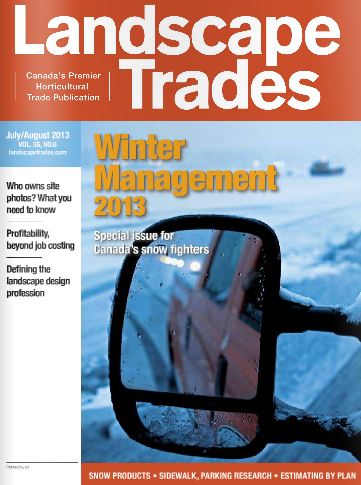
Our Lab has been featured in Waterloo AI Newsletter! (Oct. 01, 2023)
Waterloo AI Featured Lab in Oct 2023
Dr. Liping Fu is Professor in the Department of Civil and Environmental Engineering and Director of the iTSS Lab where contributes to the areas of intelligent transportation systems, public transit, road safety, and winter road maintenance. The recent research direction is exploring how AI-based models can be used of improving traffic efficiency and road safety, such as accurate traffic forecasting, AI-based dynamic signal control, and safety evaluation using big data
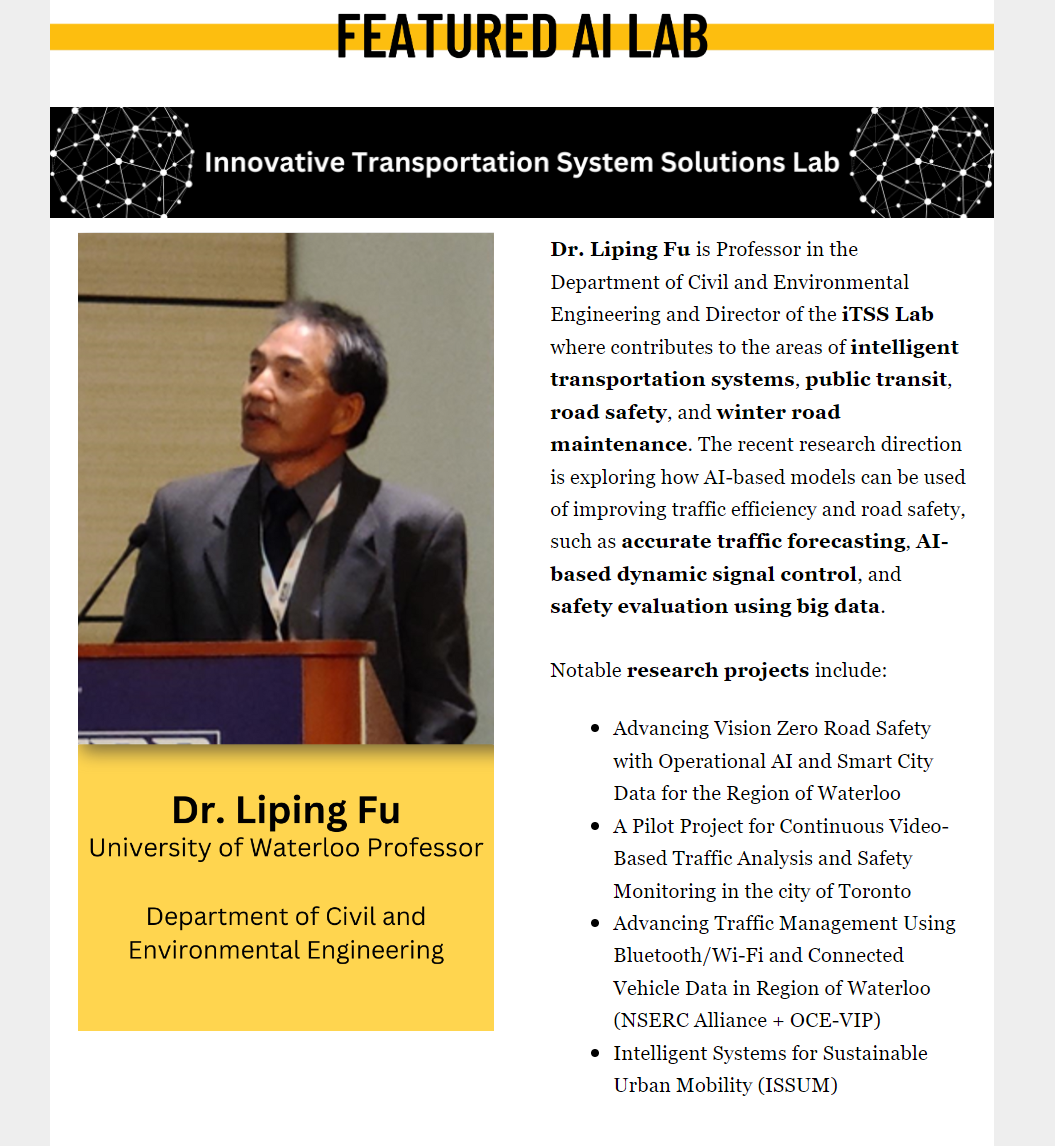 Notable research projects include:
1. Advancing Vision Zero Road Safety with Operational AI and Smart City Data for the Region of Waterloo
2. A Pilot Project for Continuous Video-Based Traffic Analysis and Safety Monitoring in the city of Toronto
3. Advancing Traffic Management Using Bluetooth/Wi-Fi and Connected Vehicle Data in Region of Waterloo (NSERC Alliance + OCE-VIP)
4. Intelligent Systems for Sustainable Urban Mobility (ISSUM)
Notable research projects include:
1. Advancing Vision Zero Road Safety with Operational AI and Smart City Data for the Region of Waterloo
2. A Pilot Project for Continuous Video-Based Traffic Analysis and Safety Monitoring in the city of Toronto
3. Advancing Traffic Management Using Bluetooth/Wi-Fi and Connected Vehicle Data in Region of Waterloo (NSERC Alliance + OCE-VIP)
4. Intelligent Systems for Sustainable Urban Mobility (ISSUM)
Click here to see the original article.
Once again, our research has been featured on the news (Feb. 13, 14')
Road salt usage causing problems in Ontario
Winter demand is taking a significant environmental and budgetary toll
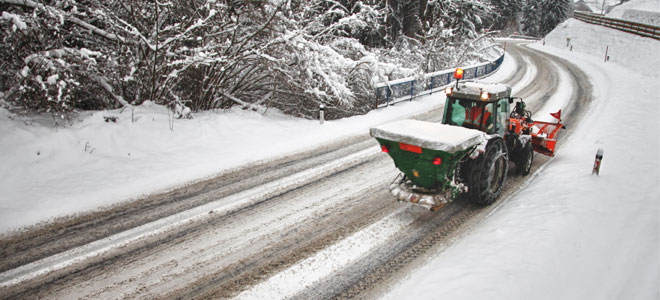
Thursday, February 13, 2014
By Barbara Carss
An elevated demand for road salt thus far this winter has repercussions for the environment, urban infrastructure and property maintenance budgets. Customary stockpiles have been depleted more rapidly than usual throughout the vast swath of Ontario that relies heavily on road salt for melting ice and improving traction.
"This is probably the worst year in 25 years in terms of the number of snow and ice events we’ve experienced,” says Tony DiGiovanni, executive director of Landscape Ontario, which counts many companies that provide snow removal services among its members. “Now we’re finding that the suppliers don’t have the inventory at the time that it’s needed. They have to get it from other places like Montreal and the United States, which adds to the costs."
The world’s largest salt mine is located on the eastern shore of Lake Huron in Goderich, Ont., making summertime barge shipments an efficient and preferred way to transport significant volumes of product to the major suppliers that sell to distributors, retailers, municipalities and directly to some contractors. Replenishing inventory is more problematic and costly during the winter season, and commercial customers are at the back of the queue since suppliers’ priority commitment is to Ontario’s Ministry of Transportation and municipalities for highway, road and street maintenance.
Almost every other consequence of the heightened need for road salt — more contaminated runoff, accelerated corrosion of exposed, vulnerable materials and increased carbon emissions due to extra truck traffic — takes a toll. Yet, many property owners and managers see slip-and-fall conditions as a more imminent threat.
"Legal liability is what drives a lot of salt use, particularly since there is no recognized standard on how much to apply for various conditions," DiGiovanni observes.
Researchers at the University of Waterloo are currently developing guidelines and associated automated measuring and monitoring systems to help owners, managers and contractors implement more sustainable snow and ice control programs and prove their diligence.The project, led by Dr. Liping Fu, a professor in the department of civil and environmental engineering, is sponsored by the Natural Sciences and Engineering Research Council of Canada (NSERC) and private industry groups including Landscape Ontario and the U.S.-based Snow and Ice Management Association. The three-year project has been testing and comparing alternative de-icing products, application forms (liquid versus solid) and quantities in differing winter weather conditions.
"The goal is to find out how much salt we need to achieve a desirable level of service under each specific snow event. How can we improve the effectiveness of maintenance operations, minimize salt usage and reduce costs?” explains Fu, who is also director of the Innovative Transportation System Solutions laboratory at Waterloo. “By the end of this project we will be able to provide some kind of guidelines on best treatment strategies and best application rates."
Although Fu’s earlier safety-inspired research on road transport in winter conditions was the starting point for this project, his new work dovetails with both environmental and cost concerns. Similarly, the Smart About Salt Council — also headquartered in Waterloo Region and endorsed by Landscape Ontario — is a not-for-profit advocacy and training organization that promotes sustainable management practices and voluntary assessment and certification of public and private properties.
Road salt’s solubility means that storm water ponds and other natural filtering processes do little to halt infiltration into watersheds or any permeable surface. Even during a less arduous winter, measurements at Toronto’s Mimico Creek following one significant storm in January 2011 revealed a chloride concentration of 18,200 milligrams per litre (mg/l).
"We are getting spikes after storms that are pretty close to seawater levels (19,250 mg/l), and it’s staying around in the groundwater and the soil. We are now seeing chloride levels that are high in the summer when it’s not being used in the city,” says Angela Wallace, a bio-monitoring analyst for the Toronto Region Conservation Authority (TRCA). “In a storm water pond, all the metals settle out and stay at the bottom of the pond and you can remove that with a backhoe. Chloride is soluble and flushes from ponds and stays in the system."
Chloride, in the form of salt, invariably arrives with development. This is causing particular concern about watersheds in burgeoning communities within TRCA’s oversight, which includes urban, suburban, exurban and rural areas stretching northward from Lake Ontario in Toronto to the Oak Ridges Moraine.
"Where sensitive species are still found, we are going to see big problems,” Wallace says. “At the mouths of rivers and streams in the southern part of TRCA’s jurisdiction, any sensitive species are already gone."
Business sense and principles would seem to automatically place a horticulturalists's association like Landscape Ontario in line with the road salt reduction philosophy, even if many members also offer snow and ice control services. DiGiovanni foresees that the pending guidelines from Dr. Fu's research team could provide the basis for a defensible standard that would support and protect contractors and property managers alike.
"Once we have something that can be proved in court, we’ll see a great reduction in salt use because there will be a reduction in liability," he says.
From a business perspective, this winter’s supply shortages and cost increases are exerting pressure on contractors with “salt inclusive” maintenance contracts. From an environmental perspective, however, such contracts can impose more discipline than the alternative "salt extra" contracts.
"If the contractors are reimbursed for the amount of salt being used, from their point of view, there is no incentive to save salt," Fu suggests.
Much depends on how property owners and managers assess and prioritize environmental concerns and liability risks. As with any adoption of new practices, consumer behaviour is also a major contributing factor.
"In Manitoba where it’s always so cold that salt doesn’t work anyway, you’ll see a lot of sand and they are driving on snow pack,” DiGiovanni reflects. “Here, it’s a matter of expectations. We just expect more. We expect to see clear pavement everywhere."
Click here to see the original article.
Our Safety-Related Research was Featured on the Media! (Feb. 6, 14')
Salt + Winter Roads = Safety, A New Study Finds
Most drivers know that during and after winter storms, applying salt to roads and highways is a good thing to do, but a new study confirms the tremendous safety benefits salt can provide to help make roads safe and prevent crashes, injuries and deaths.
The results of the study, Safety Impacts of Using Deicing Salt, were announced on Wednesday at the National Press Club in Washington by the American Highway Users Alliance, a nonprofit advocacy organization serving the transportation community.
A main finding is that road surface condition is the single most important safety factor during a winter event — more important than visibility, precipitation intensity, air temperature, wind speed, or exposure.
Other highlights from the study:
• The use of road salt reduces collisions by up to 85%.
• A 10% improvement in the surface friction of a road yields approximately a 20% reduction in crashes.
• Before- and after-analysis on four-lane roads showed a 93% reduction in crashes after deicing.
“According to the Federal Highway Administrationmore than 1,300 people are killed and more than 116,800 people are injured in vehicle crashes on snowy, slushy, or icy pavements,” each year, Gregory M. Cohen, president and chief executive of the American Highway Users Alliance, said in a statement.
Treacherous road conditions impact not only the public, but also ambulances, fire engines, police and other first responders, the report notes.
Research for the study was conducted by the University of Waterloo in Ontario, Canada and represents the most comprehensive database of winter road safety information to date, according to the alliance. The data covers nearly 60 major snow events over seven years.
To avoid winter-weather related crashes and help keep motorists safe, the AAA offers the following safety tips:
• Make certain your tires are properly inflated.
• Keep your gas tank at least half full.
• Do not use cruise control when driving on any slippery surface.
• Accelerate and decelerate slowly. It takes longer to slow down on snowy, icy roads.
• The normal dry pavement following distance of three to four seconds should be increased to eight to ten seconds.
For additional winter weather road safety information, click here and here.
Click here to see the original article.
Photos from the 2014 TRB Annual Meeting (Jan. 12-16, 2014)
iTSS at the 2014 TRB Annual Meeting (Jan. 12-16, 2014)
At the upcoming 2014 TRB Annual Meeting, the members of the iTSS Lab will be presenting a total of 14 papers!
Detailed information about our presentations is listed below:
January 13th 2014:
"Experimental Study on Effectiveness of Anti-icing Operations for Snow and Ice Control of Parking Lots and Sidewalks" by Hossain, K.S.M., Fu, L., and Olesen, A.J. (Lectern session, 8:00 - 9:45 a.m. at Maryland B, Marriott)
"Monitoring and Analysis of Winter Maintenance Operations for Parking Lots" by Omer, R., Mirotabi, R., Liaqat, Z., and Fu, L. (Lectern session, 8:00 - 9:45 a.m. at Maryland B, Marriott)
"Deicing Performance of Road Salt: Modeling and Applications" by Hossain, K.S.M., Fu, L., and Lu, C.Y. (Lectern session, 10:15 a.m. - 12:00 p.m. at Maryland B, Marriott)
"Bayesian Methodology Incorporating Highway Safety Manual for Fitting and Updating Safety Performance Functions" by Heydari, S., Miranda-Moreno, L.F., Lord, D., and Fu, L. (Poster session, 2:00 - 3:45 p.m. at Salon 2, Marriott)
"Effects of Lowering Speed Limits in Urban Areas: A Bayesian Perspective" Heydari, S., Miranda-Moreno, L.F., and Fu, L. (Poster session, 2:00 - 3:45 p.m. at Salon 2, Marriott)
January 14th 2014:
"Road Weather Information System Stations: Where and How Many to Install - Cost-Benefit Analysis Approach" by Kwon, T.J., Fu, L., and Jaing C. (Poster session, 8:30 - 10:15 a.m. at Salon 2, Marriott)
"Parking Lots and Sidewalks Under Winter Snow Events: Classification, Friction Characteristics, and Slipping Risk" by Hossain, K.S.M., Fu, L., and Law, B. (Poster session, 8:30 - 10:15 a.m. at Salon 2, Marriott)
"Comparison of Alternative Chemicals for Deicing Operations" by Hossain, K.S.M., Fu, L., and Lake, R. (Poster session, 8:30 10:15 a.m. at Salon 2, Marriott)
"Direct and Lagged Effects of Adverse Winter Weather Conditions on Operating Speed in Urban and Rural Highways: Time-Series Analysis" by Fu, T., Heydari, S., Miranda-Moreno, L.F., and Fu, L. (Poster session, 8:30 - 10:15 a.m. at Salon 2, Marriott)
"Toward a WiFi System for Traffic Monitoring in Different Transportation Facilities" by Jackson, S., Lesani, A., Miranda-Moreno, L.F. (Poster session, 8:30 - 10:15 a.m. at International Center, Hilton)
"Phase-Based Automatic Estimation of Turning Movement Counts at Signalized Intersections" by Ghods, A.H., and Fu, L. (Poster session, 10:45 a.m. - 12:30 p.m., Salon 2, Marriott)
"Multiclass Traffic Assignment Model for Predicting Transit Passenger Flows: Case Study of Beijing Subway Network" by Bingfeng, S., and Fu, L. (Poster session, 2:00 - 3:45 p.m., International Center, Hilton)
"Winter Road Surface Condition Forecasting" by Feng, F., and Fu, L.(Lectern session, 3:45 - 5:30 p.m., Delaware A, Marriott)
January 15th 2014:
"Comparison Between Parametric and Nonparametric Approaches for Road Safety Analysis: Case Study of Winter Road Safety" by Thakali, L., and Fu, L. (Poster session, 8:30 - 10:15 a.m., Salon2, Marriot)
Raqib Omer goes on CTV News! (Dec. 20, 2013)
Smart Scale is featured on UW's Daily Bullentin (Dec. 17, 2013)
Waterloo grad's innovation is worth its salt
For contractors who drop salt on parking lots and sidewalks, as well as the municipalities or owners who pay for it, there’s never been a way to measure how much salt is actually dispensed. Smart Scale, an automated salt logging and tracking system designed specifically for the winter maintenance industry, is changing that.
Developed by Raqib Omer, a Waterloo Engineering graduate, Smart Scale uses exclusive hardware wirelessly paired with GPS-enabled smart phones to track the location of a maintenance vehicle and amount of salt dispensed, and logs the information on a cloud-based system in real time. Since the cost of salt is based on size of load, property owners can be assured they’re getting what they paid for, as well as reducing risks that exist in the industry.
“With growing public concern on the environmental effects of salt, rising salt prices, and increasing fear of litigation due to slips and falls, as well as driving conditions, reliable and accurate information on salt application is becoming a necessity for maintenance contractors,” said Omer.
Omer is one of two entrepreneurs who continue to further their technologies and startups thanks to a $60,000 Scientists and Engineers in Business fellowship. The fellowship is a University of Waterloo program supported by the Federal Economic Development Agency for Southern Ontario for promising entrepreneurs who want to commercialize their innovations and start high-tech businesses.
More than 20 winter maintenance contractors in Canada and the U.S., including Urban Meadows Property Maintenance Group in Ayr, Ontario, currently use Smart Scale.
Urban Meadows owner, William Jordan, met Omer in the early testing phase of Smart Scale and the startup phase of Omer’s company, Viaesys. As the first contractor to test Smart Scale, he quickly learned there were times his company was using too much salt.
“The accuracy rate wasn’t there at all,” said Jordan. “We’re now able to accurately monitor salt usage, prevent excessive material use, keep bullet-proof records of our work and job-cost a lot better. The real time tracking of salt has helped us use up to 30 per cent less salt.”
Smart Scale is now installed on all four of his company’s trucks, which service 75 properties in Cambridge and Ayr, including parking lots for grocery stores and post offices.
Jordan, who is also chair of the snow and ice committee management sector for the horticultural trade association, Landscape Ontario, says he quickly jumped on board with Omer’s research and would like to see Smart Scale change the way salt is applied across Ontario. With no industry standards for salt application currently in place, Smart Scale could make this possible.
Dr. Liping Fu is on the WATERLOO NEWS!! (Oct 28, 2013)
Link: https://uwaterloo.ca/stories/waterloo-research-makes-railway-crossings-safer-science
October 28, 2013
Waterloo research makes railway crossings safer with science
Engineering prof leads work into software program that ranks the safety of Canada’s railway crossings
By Bob Burtt
Communications and Public Affairs
Making sure people are safe at a railway crossing involves considering everything from the condition of the road and railway, to accident history and speed of the traffic and trains.
 Liping Fu and Frank Saccomanno, Waterloo engineering professors, together with their students have developed a unique web-based software program called GradeX that is taking the guesswork out of safety at railway crossings.
Liping Fu and Frank Saccomanno, Waterloo engineering professors, together with their students have developed a unique web-based software program called GradeX that is taking the guesswork out of safety at railway crossings.
“Transport Canada makes a huge investment every year in railway crossings across the country and they want to make sure decisions are based on science,” says Fu, a professor in the Department of Civil and Environmental Engineering.
Web application assesses danger
GradeX is a web application that his research team has developed over the past decade to assess danger at over 30,000 rail crossings in Canada and to rank them according to the risk.
Transport Canada collects information about the condition of roads or highways where railways cross. They look at the condition of the pavement, traffic, sightline, speed, and other factors that affect safety.
“We take that information and run it through GradeX which gives us the rankings,” says Fu. GradeX is available on a website and is easily accessible to engineers who need the information.
Once officials know which crossings should receive attention first, they can look at which safety countermeasures would give the biggest bang for the buck. Some of the corrective measures could include signage, installation of gates, lights or, in extreme cases, a grade separation.
Ottawa fatalities
Fu hopes to begin work on a two-year, $120,000 project that will help Transport Canada improve GradeX and identify even better ways to assess potential dangers at crossings.
Last month, six people were killed and 30 injured in Ottawa when a bus crashed through a safety barrier and into a Via train. Fu said discussion about his study was in the works long before the accident.
He said there is no way of knowing whether using a tool like GradeX might have been able to prevent the Ottawa accident, but he noted the overall goal is to make crossings safer and reduce the number of rail-related accidents.
In the past, Fu has done work for the Ontario Ministry of Transport and Transport Canada and is a member of many technical committees of various professional organizations, including Transportation Research Board based in Washington D.C.. He was a past Chair of Transportation Division of Canadian Society for Civil Engineering and a recipient of Transportation Association of Canada (TAC)'s 2011 Academic Merit Award sponsored by Transport Canada for his long-term contribution to the advancement of the academic field and to the development of tomorrow's transportation leaders.
Lalita Thakali passed her Ph.D. Comprehensive Exam (Sept. 24, 2013)
Congratulations to Lalita Thakali, who successfully passed her Ph.D. comprehensive exam on September 24 2013. Lalita started her Ph.D. study since 2011 under supervisions of Dr. Liping L. Fu (supervisor), Professor at the Department of Civil and Environmental Engineering, and Dr. Tao Chen (co-supervisor), Assistant Professor at the Department of Economics.
The exam was chaired by Dr. John Chatzis, Professor at the Department of Chemical Engineering. The examining committee consisted of 3 examiners inlcuding Dr. Frank F. Saccomanno, Professor and Dr. Mahesh Pandey, Professor at the Department of Civil and Environmental Engineering, and Dr. Changbao Wu, Professor at the Department of Statistics & Actuarial Science.
Her doctoral thesis is entitled "Nonparametric methods for road safety analysis"
Congratulations, Lalita!!!
iTSS's Research on News
Ottawa would pay UW $120,000 to find better rail crossing safety tools
By Terry Pedwell
OTTAWA — Transport Canada has asked experts at the University of Waterloo to study the safety of level crossings, but the agency insists the request has nothing to do with last week's deadly collision between a city bus and a Via Rail train.
Public Works and Government Services Canada posted a notice Monday awarding a contract to UW for continued research into Transport Canada's system for evaluating rail crossing safety.
On Sept. 18, six people were killed and 30 more were injured when an Ottawa bus crashed through a lowered safety barricade and slammed into an oncoming Via locomotive. All of the dead and injured were on board the bus.
Transport Canada spokesperson Karine Martel insisted Monday there was no connection between crash and the university's research, which she said began about 10 years ago.
The agency's latest requisition for improvements to the system, known as GradeX, was signed in February 2013, Martel said.
Civil engineering professor Liping (Lee) Fu will lead the work at UW. Fu conducts research in the area of transportation networks, public transportation and safety and winter maintenance.
He has provided services to transportation agencies including the Ontario Ministry of Transportation and Transport Canada. He sits on the Washington, D.C.-based Transportation Research Board's Paratransit committee and is a member of the Canadian Urban Transit Association.
The resulting two-year, $120,000 study will look into whether there are better ways for inspectors to assess the potential dangers of railway crossings. It will gauge the effectiveness of GradeX, a computer program used by inspectors to evaluate risks at level crossings and identify ways to improve safety.
The contract tender identifies GradeX as "a one-of-a-kind, customized decision-support tool for railway safety inspectors to evaluate risks at grade crossings and identify cost-effective safety improvement strategies."
The department said UW is the intended recipient of the contract because it's the only known agency in North America with the specialized knowledge and expertise needed.
"The research team consists of both established and new researchers with extensive expertise in the fields of road and railway safety," says the advance contract award notice.
"They have been working on the issues related to highway-railway crossings over a decade and have already established reputation both in Canada and internationally."
Researchers will look at historical data on train collisions at Canadian crossings, investigate ways to prevent future accidents and determine how much it'll cost to implement new safety measures.
"The end goal is to reduce the injury and fatality rates at railway grade crossings," says the tendering document. Other universities or firms which feel they meet the study criteria have until Oct. 9 to bid for the contract.
Before the study is even completed, new rail safety regulations are expected to be in place. Those regulations are to be unveiled "this year," Transport Minister Lisa Raitt said on the weekend.
A funeral for one of the victims of last week's crash, 21-year-old Carleton University student Connor Boyd, was held Monday. And the investigation has turned its focus to double-decker bus that was involved.
On Friday, Transportation Safety Board investigators said that the safety gates, lights and bells at the level crossing in southwest Ottawa were functioning as they were supposed to and had been activated 47 seconds prior to impact.
The train's crew also applied the emergency brakes, but only two seconds prior to the crash. They did not sound the train's whistle because that was forbidden under a municipal ban in the area.
Raitt appeared to leave some safety issues to the rail industry and other levels of government to sort out, saying Sunday that new ground rules would spell out how the rail industry and municipalities — or provinces — work out "the appropriate level of safety" at level crossings. The Canadian Press
SICOPS project is featured in Landscape Trades (July-Aug 2013)
Tae's Seminar at KOTI (Aug. 21 2013)
During Tae's visit in Korea in summer of 2013, he was invited by the Korea Transport Institute (KOTI) to give a seminar.
In his seminar, he introduced various research areas and activities of the iTSS Lab, and presented his and Dr.Fu's recent work on the method for quantifying RWIS costs and benefits. The seminar was well accepted and welcomed by a large number of Korean researchers in the field of transportation engineering.
Dr. Fu's keynote speech at the 2nd ICTIS2013 (June 29th, 2013)
The 2nd International Conference on Transportation Information and Safety (ICTIS2013) was held in Wuhan, China from June 28th to July 1st, 2013, and hosted by Wuhan University of Technology (WUT).
Acknowledging Dr. Fu’s contributions to transportation research areas, the president of the ICTIS2013 Organizing Committee, Professor Xinping YAN invited Dr. Fu to attend the ICTIS2013 and give a keynote speech about his research. He delivered his keynote on monitoring, modeling and mitigation of traffic PM2.5 emissions about 40 minutes, and was very well received by the attendees.
Click here for the conference program.
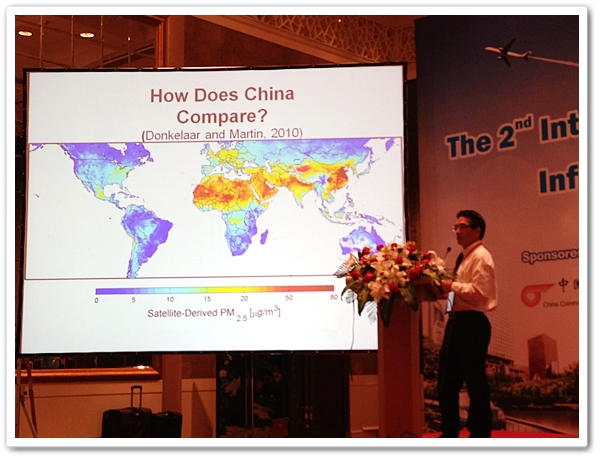
2013 International Highway Technology Summit (April. 16-18, 2013)
Professor Liping Fu delivered a talk at the 2013 International Highway Technology Summit (IHTS) held on April 16-18, 2013 in Beijing, China. The conference featured Innovative Approaches and Best Practices in four different tracks including highway engineering, bridge and tunnel structures engineering, traffic engineering, and environment and sustainability.
Click here for more information
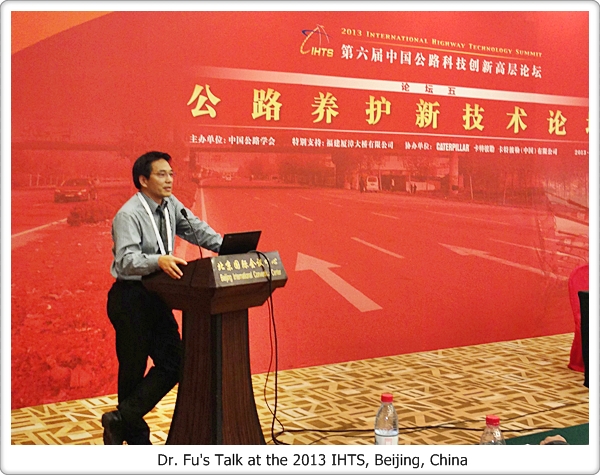
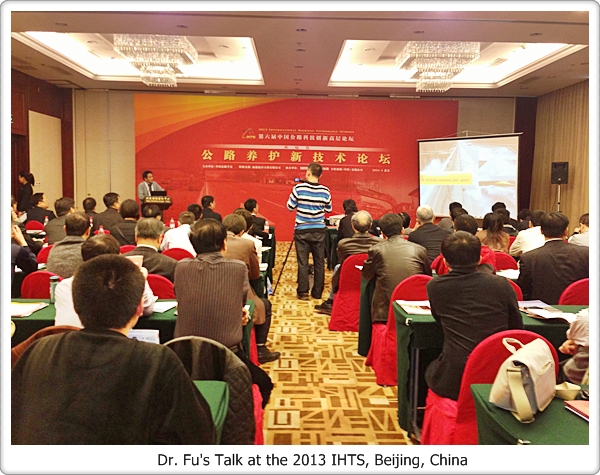
Spring 2013 TAC Technical Meeting (April. 18, 2013)
2013 Summer and Winter Maintenance Subcommittee Meeting was held at Ottawa Convention Centre on April 18th, 2013. Many industry experts from Environment Canada, Ontario, Alberta, Quebec, and Saskatchewan Ministry of Transportation, AMEC, and others have participated at the meeting to facilitate discussions on best practices for administering maintenance contracts, contracting & outsourcing alternatives, safety and traffic accommodation in maintenance, and many other maintenance-related topics.
Members of the iTSS Lab, Raqib Omer and Tae J. Kwon, also gave presentations on the topics entitled "Snow and Ice Control for Parking Lots and Sidewalks", "Automated Vision Based Winter Road Condition MonitoringSystem" and "Evaluation of Alternatives Criteria for Determining the Optimal Location of RWIS Stations". Their presentations were well presented to and received by the audiences.
iTSS's Actions at the 2013 TRB Annual Meeting (Jan. 13-17, 2013)
Members of iTSS lab attended the 92nd TRB meeting and presented a total of six accepted TRB papers in both lectern and poster sessions. Detailed information on our presentations at the meeting is as follows:
Authors: Johnny Cao, Lalita Thakali, and Liping Fu.
Authors: Tae J. Kwon, Liping Fu, and Chaozhe Jiang.
Authors: Tae J. Kwon, Liping Fu, and Max S. Perchanok.
Authors: Raqib Omer, Liping Fu, and Zara Liagat.
Authors: Liping Fu, Raqib Omer, S M Kamal Hossain, and Chaozhe Jiang.
Authors: Taimur Usman, Liping Fu, and Luis F. Miranda-Moreno.
More News???
Click "here" to see the archived news!


